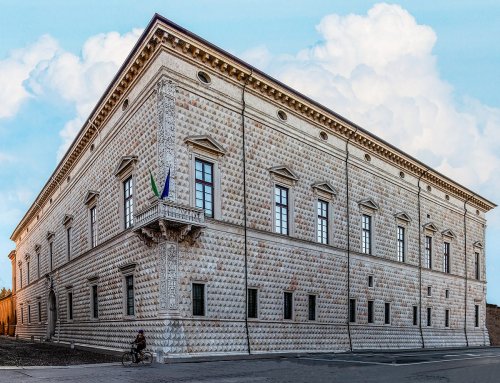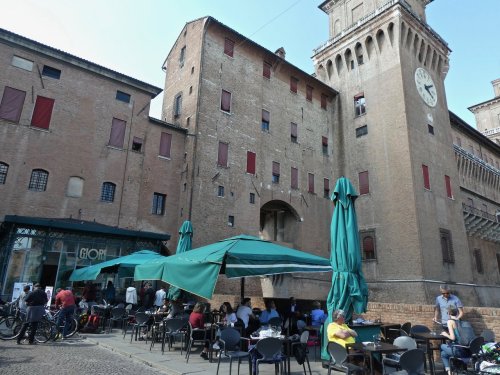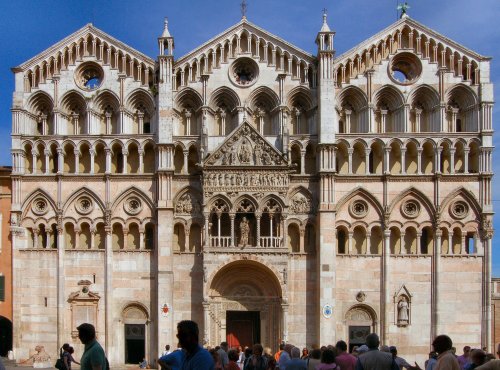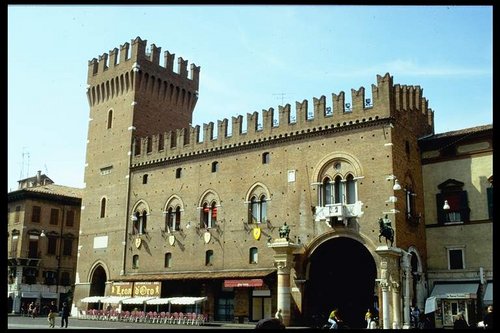The origins of Ferrara are wrapped in mystery. Its name is mentioned for the first time in a document dating to 753 A.D., issued by the Longobard king Desiderius. In the earliest centuries of its life the city had several different rulers: first it was a fief of the Canossa family and later it gained enough freedom to become an independent Commune. Some years followed of fierce internal struggles between the Guelph faction, headed by the Adelardi family and the Ghibelline faction, led by the Torelli-Salinguerra. The Este family took advantage of this confused situation and took control of the city, conquering the utmost power after several difficulties.
The great cultural season began in 1391, when the University was founded and afterwards culture and magnificence grew unceasingly, until they reached the level of the most important European courts. Humanists like Guarino Veronese came to Ferrara, together with artists like Leon Battista Alberti, Pisanello, Piero della Francesca, Rogier van der Weyden and Tiziano. The local pictorial school, called "Officina ferrarese" (Workshop of Ferrara) produced the masterpieces of Cosmè Tura, Ercole de' Roberti and Francesco del Cossa. All the best musicians of the time worked for the Dukes of Ferrara, who also inspired the immortal poetry of Boiardo, Ariosto and Tasso.
Niccolò III, the diplomat, Leonello, the intellectual, Borso, the magnificent, Ercole I, the constructor, and Alfonso I, the soldier: these are the names of some famous lords of Ferrara, still recalled together with those of the family's princesses: the unlucky Parisina Malatesta, the wise Eleonora d'Aragona, the beautiful and slandered Lucrezia Borgia, Renèe of France, the intellectual follower of Calvinism, as well as the elegant and sophisticated Lucrezia, Leonora and Marfisa.
The small State was always in precarious equilibrium among its powerful neighbours, especially Venice and finally it became a province of the Papal States (1598). There began long centuries of stagnation, interrupted by some single figures of patrons like Cardinal Tommaso Ruffo. After the brief reign of Napoleon, Ferrara had an active role in the "Risorgimento" and in the history of the Kingdom of Italy, eventually becoming the modern city rich in memories of the past that we can admire today.
Largo Castello - phone 0532 299233
closed on Mondays
partially accessible
How to get there:
The castle is situated right in the heart of Ferrara, almost right in the centre with respect to the present day city walls.
- by car - on the northern edge of the restricted traffic zone, in Largo Castello there is car parking space for cars with foreign registration plates;
- by bus - routes 1, 2 and 9 from the railway station (journey time 5-9 min.);
- on foot - about 25 min. walk from the railway station
Centuries went by and the danger of uprisings ceased. Then the castle became a splendid court residence and it was embellished with roof-terraces, marble balconies, the Renaissance-style courtyard and sumptuous apartments.
We can still visit the narrow dungeons where the love story between Ugo and Parisina ended tragically. Parisina was the second wife of marquis Niccolò III, a libertine and much older than she was; she fell in love with her stepson Ugo, the natural son of the marquis and his favourite mistress, the beautiful Stella dei Tolomei. The two young lovers, both twenty years old, were caught in the act of flagrant adultery and beheaded after a short, sad imprisonment in the castle dungeons, in 1425.
A long ramp, originally used for artillery, leads to the first floor, where the Duchesses' Garden welcomes us; this is a graceful roof-garden surrounded by a wall. Then visitors can admire the elegant geometrical lines of the Ducal Chapel, according to an old tradition, this was the chapel of the Calvinist duchess Renèe of France.
Some halls decorated with splendid painted ceilings come next: they are the work of the Filippi family and their collaborators (16th century).
The Room of Dawn, where Chronos sits in the middle, among the Fates, surrounded by the four phases of the day: Dawn, Morning, Sunset and Night.
In the Little Room of Games Pompeii-style scenes of putty playing surround scenes of ancient Rome games, usually very violent and in the middle, the Fours Seasons charming dance.
At last, the Big Room of Games is richly decorated with scenes of the sports the last duke Alfonso II was fond of.
free admission
facilitated access next to the bell tower
How to get there:
Restricted traffic zone.
- by bus - routes 2 and 3/c from the railway station;
- on foot - about 25 min. walk from the railway station
The Cathedral dates from the 12th century and it bears witness to all the historical periods of the city.
The outstanding façade is divided into three sectors and its lower part was built in Romanesque style. The remarkable low relief of Saint George and the Scenes from the New Testament over the main doorway are the work of the sculptor Nicholas. The upper part was built some decades later in a Gothic style and it is characterized by many small arches and deeply splayed mullioned windows, an extraordinary Last Judgement by an unknown sculptor can be admired over the central loggia. To the right side of the façade there is a statue of Alberto d'Este, inserted in a niche.
The south side along Trento Trieste square is decorated with two galleries and small columns of various shape and it ends with the impressive Renaissance bell-tower, in white and pale rose marble, an unfinished work attributed to Leon Battista Alberti.
The apse, whose charming design is embellished by arches in terracotta and by marble capstones, is the work of Biagio Rossetti, the most famous architect and town-planner of Ferrara.
The interior of the cathedral was entirely transformed in the 18th century in a classic Roman style. Besides the sumptuous decoration, visitors can admire some older works o art, such as the bronze statues of the Crucifixion and the Saints George and Maurelio, by Niccolò Baroncelli and Domenico di Paris (15th century), at the far end of the right nave, in the altar beside this monument, we notice the splendid painting portraying the Martyrdom of Saint Lawrence, by Guercino (17th century).
The vault of the apse contains the fresco of the Last Judgement, painted by Bastianino (16th century) and inspired by Michelangelo's model in Sixtine Chapel.
San Romano Street - phone 0532 209988
closed on Mondays
accessible with help The Cathedral Museum, in the nearby little church of San Romano, completes the visit of the cathedral, since it houses objects which once belonged to the church.
First of all, the old door panels of the organ, representing St. George killing the Dragon and the Annunciation, a masterpiece by Cosmè Tura. The Panels of the Months are exceptional sculptures which were part of the medieval Door of the Months, southern doorway to the temple, demolished in the 18th century. We must then mention the statues by Jacopo della Quercia, some 16th century large tapestries by Johannes Karcher, a rich collection of illuminated antiphonal hymn books, some reliquaries, some paintings and other works of art.



